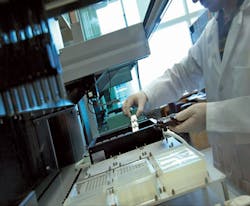GENOMICS/BONE MARROW DONATION: Next-gen DNA sequencing enables reliable donor matching service
A new lab test at Children's Hospital of Philadelphia (PA; CHOP) uses next-generation sequencing (MiSeq from Illumina; San Diego, CA) in an effort to improve transplant outcomes through advanced assessment of donor compatibility. The test will expedite donor selection using bone marrow registries, and fuel research in immunological infectious disease as well as pharmacogenomics.
"This new test addresses a 60-year-old problem," said Dimitri Monos, Ph.D., director of the hospital's Immunogenetics Laboratory in the Division of Genomic Diagnostics. Since the discovery of human leukocyte antigens (HLAs) in the early 1950s, characterizing their gene sequences accurately and thoroughly had been difficult, but the new technology provides a significant advance.
This is a comprehensive test, based on extensive research by Monos and his colleagues. "This is a new, disruptive technology, with the potential to transform research and clinical practice, in transplantation and other fields," says Robert Doms, MD, Ph.D., pathologist-in-chief at CHOP.
HLA genes are the most complex gene family known in the entire human genome. Current tests often provide ambiguous and limited results by sequencing only segments of HLA genes and failing to distinguish among different alleles suggested by a given sequence. In addition, preliminary testing often must be followed by a second level of reflexive testing.
The new test streamlines the process and provides the highest resolution possible by covering the full HLA genomic region. It distinguishes among 10,500 alleles of all known HLA types, and can fully characterize new alleles yet to be discovered. Next-gen sequencing promises to dramatically increase the list of HLA alleles.
Monos and colleagues developed a new protocol for HLA genotyping using the MiSeq platform. They validated the test by comparing its results with previously sequenced data from a collection of over 300 samples characterized at five different genes. Agreement between the methodologies was 100%.
CHOP will offer HLA typing as a service to medical and academic centers. The test's most significant short-range impact may be in typing donors in bone marrow/stem cell registries. Because of the high cost of performing high-resolution HLA typing under current methods, most potential donors are typed at low- or intermediate-resolution, with a repeat, high-resolution test needed to assess compatibility when a patient needs a transplant. The new method will save time and expense by initially typing donors at the allele level. No additional typing will then be necessary.
"This faster, more thorough technology allows us to better account for subtle genetic differences between individuals," says Monos. The team expects this knowledge to yield clinical benefits by facilitating more precise matches between transplant donors and recipients, and assessing the significance of mismatches that were previously uncharacterized. Additionally, by focusing on fine details of immune responses, the technology can advance understanding of how specific individuals respond to infectious diseases, vaccinations, and particular drugs.

